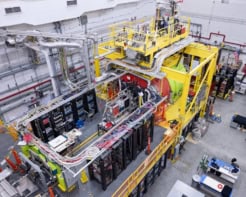In 1982, the US Department of Energy (DOE) made a promise about nuclear waste. By 1 February 1998, it promised, the department would find a safe place in which to store the thousands of tons of spent fuel and high-level radioactive waste generated by civilian nuclear power plants. But when the deadline passed last month, no permanent - or indeed temporary - storage site existed, and none is likely to be built in the near future either.
The broken promise has led to disagreements between the government and the utilities companies that operate nuclear power plants. Underlying the conflict is the fact that the DOE has charged electricity users literally billions of dollars to cover the costs of building a site for the burial of radioactive waste. More than 40 000 tons of used reactor fuel are currently kept on site at 71 nuclear power plants.
The issue has already spilled over into the law courts. Last year, 36 reactor operators brought a case against the DOE in a federal court, arguing that the department should accept responsibility for the waste. The court ruled that the DOE has an obligation to accept used fuel rods from nuclear plants. Moreover, the court found that the DOE cannot excuse itself from the obligation by arguing that it has nowhere to put the waste.
Since then, the utilities and the DOE have duelled over what to do to solve the problem. The DOE has offered to cover some of the extra costs incurred by having to store waste on site, but that offer has met a chilly reception. “What the utilities want is for the energy department to take their spent fuel, ” says Jay Silberg, a lawyer for the utilities.
The DOE counters by pointing to the complexity of finding permanent storage. “The magnitude and seriousness of this task cannot be underestimated, ” says Lake Barrett of the DOE. “But we believe it would be a mistake to divert our resources and efforts to a temporary ‘fix’ which could undermine our focus on obtaining a permanent solution, ” he adds.
The focus of the DOE’s efforts is a site in Yucca Mountain, Nevada. Scientists and engineers are carrying out a “viability assessment”, due in autumn, of the site’s suitability as a permanent waste repository. If the assessment is favourable, the DOE will prepare an environmental impact statement next year, and work on the site could begin in 2001.



